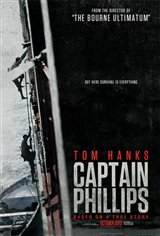Maersk Alabama
The Maersk Alabama is a container ship weighing approximately 17,000 tonnes, operated by Maersk Line Ltd. and Waterman Steamship. It was built in 1998 and originally sailed under the Denmark flag as the Alva Maersk. In 2004, she was reflagged to the United States as the Maersk Alabama and is still sailing today. The movie Captain Phillips(2013) is based on the April 2009 hijacking of this ship.
On April 7, 2009, due to the increased presence of pirates in certain parts of the Indian Ocean, the U.S. Maritime Administration released an advisory warning ships to stay at least 1000 km off of the coast of Somalia. The Maersk Alabama, carrying humanitarian aid bound for Kenya, was sailing nearby. Despite the advisory, the ship, captained by 53-year-old Richard Phillips of Vermont, sailed within 400 km of the Somalian coast.
On April 8, four Somali pirates, all in their teens and armed with AK47s, boarded the Maersk Alabama, seized the bridge, and captured several crew members. Unfortunately, while they were boarding the Alabama, the pirates’ speedboat sank, trapping them on the American ship. One of the Alabama’s crew members, Reza, managed to sound an alarm and those of his companions who hadn’t yet been seen hid in the ship’s engine room, where the chief engineer took control of the ship’s steering. Reza offered to take the lead pirate to the engine room so they could gain control of the ship. When they entered the engine room, the crew overwhelmed the pirate, stabbed him in the hand, and took him hostage.
After learning what had happened, the three remaining pirates confronted the crew with their guns ready. Knowing the potential danger of the situation, Captain Phillips offered himself up as a hostage in return for the crew’s safety. The deal was accepted. Immediately, the crew tried to think of a way to free their captain and offered to trade the injured pirate leader for Phillips. Unfortunately, the pirates failed to honor the hostage exchange and taking their leader and Phillips with them, escaped in a lifeboat.
On April 9, following the departure of the lifeboat, Shane Murphy took over command of the ship. The USS Bainbridge and the USS Halyburton responded to Murphy’s calls for assistance and provided the ship with an armed escort for the remainder of its journey. The Alabama sailed safely into Mombasa port in Kenya on April 11. In the meantime, the USS Bainbridge had been sent to recover Captain Phillips. They found the lifeboat not long later and made contact with the pirates using a walkie-talkie, which had been taken from the Alabama. The pirates wanted $2 million and safe passage to Somalia in exchange for Phillips’ release. With the help of the FBI, the two sides entered into negotiations. Somali elders and the families of the pirates also attempted to mediate the situation. They dismissed the ransom demand, requesting simply that the teenagers be allowed to return safely home.
On the night of April 10, Phillips jumped off of the lifeboat and tried to swim to the nearby Bainbridge. The pirates caught sight of him in the moonlight and quickly jumped in after him. Back in the pirates’ hands, Phillips was beaten and tied up. Negotiations continued the following day but were quickly failing. By April 12, the lifeboat had run out of fuel and the pirates became more threatening towards the captain. The injured pirate leader asked to come on board the USS Bainbridge to receive medical attention and was kept there. During his absence, negotiation attempts broke down entirely. At approximately 7:00 p.m. that night, in a rescue mission that had the approval of United States President Barack Obama, Navy SEALS shot and killed the three remaining pirates and retrieved Captain Phillips. A year later, he published a book about his ordeal called A Captain’s Duty: Somali Pirates, Navy SEALS, and Dangerous Days at Sea, which likely provided some of the material for the movie Captain Phillips (2013).
The surviving pirate, Abduwali Abdukhadir Muse, was taken to the United States to face charges. Although he was thought to be around 19 at the time of the hijacking, possibly younger, Muse was tried as an adult. He was sentenced in a New York federal court in May 2010 to nearly 34 years in prison.
Muse’s sentencing was not the only legal event that resulted from the hijacking. Eleven members of the Maersk Alabama crew filed lawsuits against the operators of the ship, alleging that the two companies endangered their lives by having them sail close to Somalia despite the issued advisory warning. Phillips, who was deemed a hero by the crew for his self-sacrifice, was not named in the lawsuits.
The hijacking of the Maersk Alabama marked the first time in over 200 years that a ship flying under the American flag had been boarded by pirates. It was also the first time in recent history that seamen had successfully fought back against pirates in the waters off Somalia. Despite the publicity surrounding the Alabama and an increased security presence in the area, pirating continues to be an issue in the Indian Ocean. There have even been further failed attacks on the Maersk Alabama. It is estimated that pirates have seized millions of dollars in ransom money from ships commanded by crews from around the world. The story of the Maersk Alabama is just one of many.
